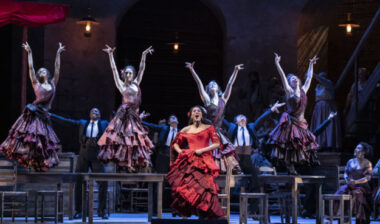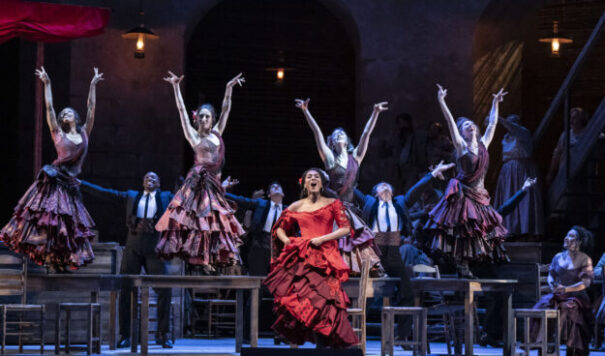 United States Bizet, Carmen: Soloists, Children’s Chorus – Uniting Voices Chicago, Chorus and Orchestra of Lyric Opera of Chicago / Henrik Nánási (conductor). Civic Opera House, Chicago, 11.3.2023. (JLZ)
United States Bizet, Carmen: Soloists, Children’s Chorus – Uniting Voices Chicago, Chorus and Orchestra of Lyric Opera of Chicago / Henrik Nánási (conductor). Civic Opera House, Chicago, 11.3.2023. (JLZ)

Production:
Director – Marie Lambert-Le Bihan
Sets – Robin Don
Costumes – Robert Perdziola
Lighting – Chris Maravich
Chorus Master – Michael Black
Children’s Chorus Master – Josephine Lee
Choreographer – Stephanie Martinez
Cast:
Moralès – Ian Rucker
Micaëla – Golda Schultz
Don José – Charles Castronovo
Zuniga – Wm. Clay Thompson
Carmen – J’Nai Bridges
Frasquita – Denis Vélez
Mercédès – Katherine DeYoung
Escamillo – Andrei Kymach
Lillas Pastia – Alejandro Luévanos
Dancaïre – Laureano Quant
Remendado – Ryan Capozzo
With this new Carmen, Lyric Opera of Chicago has revived one of the works that was part of its 1954 opening season. The perennially popular opera benefits from the efforts of director Marie Lambert-Le Bihan’s designer, Robin Don, to create sets that both establish the tone and provide a useful space for acting.

The traditional sets include a spacious town square in Act I, Lillas Pastia’s multi-level inn for the second, a narrow mountain pass in the third and bullfighting grounds for Act IV. The last act is especially inventive: prominent doors shut on the space one by one while Carmen and Don José have their ultimate encounter, and the chorus’s interjections about the successful bullfight underscore their exchange. This final act is, perhaps, the most successful of the four both visually and dramatically.
The inclusion of spoken dialogue returns a well-known element of the opera to the stage. But this raises questions here about dialogue in an opera house – the sound levels are low and the delivery had pauses that halted the flow between musical numbers and spoken passages, and even within exchanges. Perhaps the size of the performance space is a consideration, since it might have worked better in a smaller area. Nevertheless, the dialogue assisted in connecting the libretto and the action, without the omissions that sometimes occur.
Among the other concerns is the staging of the children’s chorus at the changing of the guard in the first act. The scene’s blocking puts the chorus at the center of the stage, with the entry of the soldiers seeming incidental even though the children mimic them. That stated, the chorus had a good, blended sound, but the tempos of the chorus and the orchestra differed at times.
Issues with tempos occurred elsewhere, as in the first part of Act II when the performers on stage were out of synch with the orchestra. That lack of coordination may be the result of the choreography, since the loud taps on the wooden tables were also out of synch. It was ambitious to try to coordinate orchestra, vocal ensembles and choreography, yet it is possible to make the elements combine if the focus remains on the pit and, specifically, conductor Henrik Nánási.
Nánási has conducted at Lyric Opera several times in recent years, including The Marriage of Figaro (2015-2016) and Madama Butterfly (2019-2020). Even with his experience in the house, the prelude to Act I failed to blend, with the brass and percussion dominating the sonorities. At times, the strings seemed missing, and that detracted from the rich sound that characterizes the well-known prelude as well as other numbers. While not chronic, similar issues of balance affected scenes in the first two acts. Later in the evening, some of the horn passages in Act III were marred by intonation problems, but that was resolved by the fourth act. (No doubt all the issues affecting this Carmen on the first night will improve in successive performances.)
As to the principals, J’Nai Bridges brought her well-considered interpretation to the role. She was at her best in Act IV, where she gave the final exchange with Don José full voice. As Don José, Charles Castronovo brought his warm, resonant sound to the role, and was particularly effective in the first act’s ‘Seguidilla’, which hinted at the intensity he would bring to the final act. It was a pleasure to hear soprano Golda Schultz as Micaëla and to enjoy her impassioned yet lyrical approach to the character’s two arias. Her extroverted treatment of her aria in Act III juxtaposed the personas of Micaëla and Carmen and set up the dénouement.
Carmen continues to hold its place in opera repertoire, and the concerns with the details of this production should not deter anyone from enjoying the efforts of those involved, especially all the talented principals. The combination of a compelling story, memorable music and three-dimensional characters makes it an opera that endures. If the character of Carmen is difficult to pin down when it comes to the motivation that brings the drama to its conclusion, this staging has succeeded not only in allowing audiences to enjoy the work, but in provoking them to think about it too.
James L. Zychowicz
